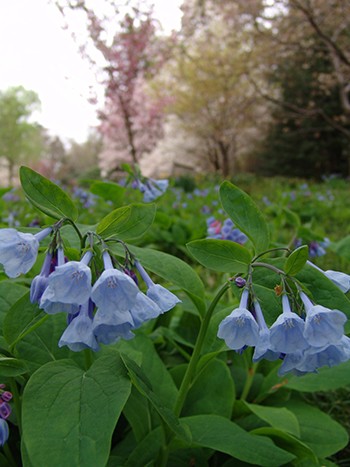Plants of the Week: April 18
Mertensia virginica
Virginia Bluebells always remind me of my time at the Edith J Carrier Arboretum in Virginia. There are pathways through the woods that are lined with them, truly spectacular when they are in bloom. Native to Eastern North America, these herbaceous perennials can be seen here on Swarthmore’s campus growing abundantly in the shady parts of the Cherry Border as well as in the Glade Garden. M. virginica sees the height of its season in March and April before completely dying back to dormancy by mid-summer. They produce scorpioid cymes of blue and pink, trumpet-shaped, pendulous flowers; very similar to those of Pulmonaria. photo credit: R. Maurer
Podophyllum peltatum
The Meetinghouse Woods are carpeted with an army of Podophyllum, just emerging; vaguely reminiscent of an overcrowded beach filled with umbrellas. This native, rhizomatous perennial, of which only the leaves and fruit are visible, can be found growing in shady, dry, woodlands throughout Eastern North America. The subterranean stem produces two pale-green, spotted, umbrella-like leaves that emerge on a single petiole. Between the two leaves a single, waxy, white flower hangs. When pollinated the flower matures to a single, fleshy, gold, edible fruit that is reportedly used for making jellies and jams. photo credit: J. Bickel
Syringa ‘Betsy Ross’
Early April marks the beginning of the flowering period of the Lilac Collection. The fragrances alone make this one of my favorite times of year. In front of the Meetinghouse is the Lilac Collection, and at the very head of the collection right outside the front door sits S. ‘Betsy Ross’, Named for the woman in history credited with making the first American flag. This cultivar was created by the U.S National Arboretum as a result of the hybridization program initiated in the early ‘70s by Dr. Donald Egolf in an effort to create a lilac with considerable disease resistance and hardiness to warmer climates. Syringa comes from the Greek syrinx, meaning hollow tube or pipe, allegedly coming from the easily hollowed stems, which were used to make reed pipes and flutes. This cultivar boasts large, heavy panicles of pure white, sweet smelling flowers, that are open now in mid- April. photo credit: J. Bickel






![Podophyllum peltatum JTB [2]](/wp-content/uploads/2016/04/Podophyllum-peltatum-JTB-2-400x300.jpg)
![Syringa 'Betsy Ross' JTB [2]](/wp-content/uploads/2016/04/Syringa-Betsy-Ross-JTB-2-400x300.jpg)
No Comments